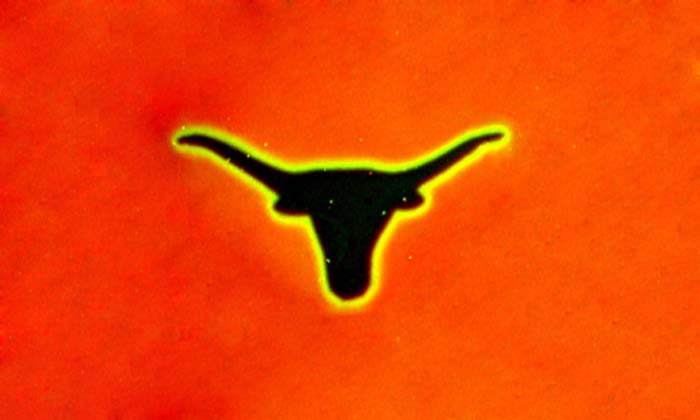In a set of two recent papers, Andy Ellington and his lab show how DNA can make pictures, but more importantly, that DNA circuits could someday be used to manufacture drugs or grow organs, such as a new heart.

DNA is, of course, the ultimate computer program. Using various combinations of just four nucleotides as code, the über-molecule spits out an amazing diversity of living, breathing machines. It generates ginormous mounds of proteins, cells, brains, and bodies. Living things that combined together do other things.
What if we could tap into DNA’s computational ability to bioengineer new stuff?
That’s the question that synthetic biologist Andy Ellington, his team, and their colleagues around the country have been working on now for years.
Building Bevo
Recently, Ellington’s team discovered a secret to creating programmable DNA circuits, and demonstrated that the circuits are capable of creating complex images. They published a paper about the technique online in late September in Nature Chemistry.
In a simple proof-of-concept, they showed that DNA could self-organize into an image of the UT Longhorn icon by projecting ultraviolet light onto agar containing circuits made to detect the edge of the image.
They created “photography” DNA circuits that would fluoresce within an illuminated pattern (e.g. the Longhorn) when light was beamed in that pattern on agar gel. They also developed circuits that would make a fluorescent edge around the illuminated area.
When the light was removed, the DNA circuits self-assembled, leaving only the edge of the original projected image.
“In a sense, we watched the Longhorn emerge from a sea of nothing,” said Ellington. “The implications of this beg to ask what else DNA can self-assemble into. The answer, of course, is even bigger and better things (think a liver or heart), though that is still somewhat in the realm of science fiction.”
Laboratory Evolution
Making cool images with DNA circuits is one thing, but a grand challenge bioengineers face is how to take an existing biomolecule and evolve its function, said Jared Ellefson, a graduate student in the Ellington lab.
Evolution in the natural world creates new functions (like a new feather color or a new molecule) over millions of generations (and potentially millions of years) based on random genetic mutation and natural selection. Bioengineers don’t have millions of years to wait for such fundamental changes.
“In the lab, we would like to speed up this process. It is critical,” said Ellefson. “Flu viruses mutate so rapidly that we need to develop new vaccines yearly. Biofuels may one day be the sole source of petroleum derivatives, and we need to be able to manufacture these quickly. These future problems will be solved by coopting biological processes, essentially forcing things like bacteria to be bio-factories.”
The problem is that altering biology is extremely difficult.
“We often don't understand enough to mutate organisms to do new tricks,” said Ellefson. “Most mutations completely obliterate a biological function, with only a small percentage doing something useful.”
In a new paper published November in Nature Biotechnology, Ellefson, Ellington, and the team show that they can overcome this obstacle by developing methods to pull molecular needles out of the haystack. They can evolve millions and billions of biomolecules in the lab, and then use their method to find the best functional versions of those molecules out of millions of billions of nonfunctional mutants.
Their method for rescuing the good molecules, called “compartmentalized partnered replication” or CPR, has proven to be extremely effective.
“It blew other methods out of the water,” said Ellefson. “Our initial effort proved successful at engineering single biomolecules, but we look forward to engineering more complex goals, such as synthetic metabolic pathways.”
For example, the CPR technology could be used to quickly evolve and screen complex genetic circuits that could someday spit out something such as an anti-malarial drug.
For more information, contact: Andy Ellington, ellingtonlab@gmail.com, 512-232-3424

















Comments